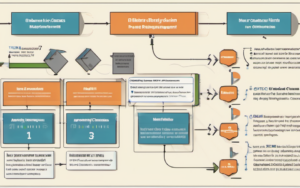The buzz around blockchain technology is undeniable. From its origins in cryptocurrency to its potential to revolutionize various industries, blockchain has captured the imagination of technologists and investors alike. But is this excitement justified, or is blockchain technology simply another fleeting technological hype? Let’s delve into the complexities of this transformative technology and explore whether it lives up to its immense potential.
1. Introduction
1.1 The Blockchain Hype Cycle
The trajectory of blockchain technology mirrors many technological innovations: an initial burst of hype, followed by a period of disillusionment as the technology struggles to meet overblown expectations, and finally, a more realistic assessment of its capabilities and limitations. We’re currently navigating this complex landscape, attempting to separate the hype from the reality of blockchain’s potential impact. Understanding where we stand in this cycle is crucial for a balanced perspective on the future of this technology. The “blockchain technology hype vs reality” debate is ongoing, and this exploration aims to provide clarity.
1.2 Defining Blockchain Technology
At its core, blockchain technology is a distributed, immutable ledger. Think of it as a digital record-keeping system shared across a network of computers. This decentralized nature is key; no single entity controls the data, making it highly secure and transparent. This shared ledger records transactions in “blocks,” which are then chained together chronologically, hence the name “blockchain.” Each block contains a cryptographic hash of the previous block, ensuring the integrity and immutability of the entire chain.
1.3 Scope of this Discussion
This discussion will examine the core concepts of blockchain technology, explore its current applications across diverse sectors, and analyze its challenges and limitations. We will also delve into the potential future applications of blockchain, including emerging trends like the metaverse and NFTs, and assess whether the initial hype surrounding blockchain technology is justified, considering its “future applications of blockchain technology” and its overall impact. Ultimately, we aim to provide a balanced perspective on blockchain’s potential impact on various industries.
2. Understanding Blockchain Technology
2.1 Core Concepts: Decentralization, Immutability, Transparency
Decentralization is the cornerstone of blockchain’s strength. Unlike traditional databases controlled by a central authority, a blockchain is distributed across many computers, making it resistant to censorship and single points of failure. Immutability means that once data is recorded on the blockchain, it cannot be altered or deleted, ensuring data integrity. Transparency, while not absolute in all blockchain implementations, signifies that the transactions are publicly viewable (depending on the type of blockchain), fostering trust and accountability.
The combination of these three core principles – decentralization, immutability, and transparency – forms the foundation of blockchain’s security and robustness. This makes it a powerful tool for applications requiring high levels of trust and security.
2.2 How Blockchain Works: A Simplified Explanation
Imagine a digital ledger shared amongst many computers. Each transaction (e.g., a cryptocurrency transfer or a supply chain movement) is bundled into a “block” along with a timestamp. This block is then verified by multiple computers in the network (a process called consensus) and added to the chain. The cryptographic hash ensures that any tampering with a previous block would be immediately detectable. This process ensures the integrity and security of the entire blockchain.
The verification process, also known as consensus mechanism, varies depending on the type of blockchain used. Proof-of-work, the mechanism used by Bitcoin, requires significant computational power, leading to some energy consumption concerns. Other mechanisms, like proof-of-stake, aim to improve efficiency and reduce energy consumption.
2.3 Types of Blockchains: Public, Private, Consortium
Public blockchains, like Bitcoin, are open to anyone, allowing anyone to participate in the network and validate transactions. Private blockchains, on the other hand, are permissioned, meaning access is restricted to authorized participants. Consortium blockchains are a hybrid approach, allowing multiple organizations to collaborate on a shared blockchain network. Each type has its own advantages and disadvantages, making them suitable for different applications. Understanding these distinctions is critical when evaluating the suitability of blockchain for a specific use case.
3. Current Applications of Blockchain
3.1 Cryptocurrencies: Bitcoin and Beyond
Bitcoin, the first and most well-known cryptocurrency, demonstrated the potential of blockchain technology to create a decentralized, peer-to-peer digital currency. Since then, numerous other cryptocurrencies and blockchain-based applications have emerged, further expanding the scope of this technology. This early adoption of blockchain in the financial sector helped to demonstrate its potential for secure and transparent transactions.
The success of Bitcoin and other cryptocurrencies has paved the way for further innovation and adoption of blockchain technology in various industries.
3.2 Supply Chain Management: Enhancing Transparency and Traceability
Blockchain’s immutability makes it ideal for tracking goods throughout the supply chain. Each step, from origin to delivery, can be recorded on the blockchain, providing enhanced transparency and traceability. This helps to combat counterfeiting, improve efficiency, and enhance accountability. Using blockchain for supply chain management can significantly reduce the risk of fraud and increase customer trust.
This application directly addresses issues of provenance and authenticity, improving product safety and consumer confidence.
3.3 Healthcare: Secure Data Management and Interoperability
The healthcare industry generates vast amounts of sensitive data. Blockchain offers a secure and private way to manage this data, ensuring patient privacy and data integrity. Furthermore, blockchain can facilitate interoperability between different healthcare systems, allowing for seamless data sharing among providers. This can lead to improved patient care and more efficient healthcare systems.
Secure data management and interoperability are crucial for effective and ethical healthcare delivery.
3.4 Voting Systems: Improving Security and Trust
Blockchain can enhance the security and transparency of voting systems. By recording votes on an immutable ledger, blockchain can prevent fraud and manipulation, while also increasing voter confidence in the integrity of the election process. This offers a potential solution to long-standing issues of voter fraud and election integrity.
The potential for enhanced security and transparency could significantly improve public trust in democratic processes.
3.5 Digital Identity: Secure and Decentralized Identity Management
Blockchain can be used to create secure and decentralized digital identities. This allows individuals to control their own data and share it selectively with different organizations, enhancing privacy and security. This approach offers a more user-centric and secure alternative to traditional centralized identity management systems.
This approach empowers individuals with more control over their personal data.
4. Challenges and Limitations of Blockchain
4.1 Scalability Issues: Transaction Speed and Capacity
One of the major challenges facing blockchain technology is scalability. Many blockchains struggle to handle a high volume of transactions, resulting in slow transaction speeds and high fees. Research and development efforts are focused on addressing these scalability issues, exploring solutions like sharding and layer-2 scaling solutions. These issues are crucial to overcome for widespread adoption.
Overcoming these limitations is essential for blockchain technology to become truly mainstream.
4.2 Regulatory Uncertainty: Legal and Compliance Challenges
The regulatory landscape surrounding blockchain technology is still evolving, creating uncertainty for businesses and developers. Different jurisdictions have different regulations, making it challenging for companies to navigate the legal and compliance requirements associated with blockchain applications. Clear and consistent regulations are needed to foster innovation and adoption.
Regulatory clarity is crucial for the long-term growth and sustainability of the blockchain ecosystem.
4.3 Energy Consumption: Environmental Concerns with Proof-of-Work
Certain blockchain implementations, particularly those using the proof-of-work consensus mechanism, consume significant amounts of energy. This raises environmental concerns, prompting research into more energy-efficient consensus mechanisms like proof-of-stake. Addressing these environmental concerns is vital for the sustainable development of blockchain technology. The shift towards more eco-friendly consensus mechanisms is ongoing.
4.4 Security Risks: Vulnerabilities and Attacks
While blockchain technology is inherently secure, it is not immune to vulnerabilities and attacks. Smart contract vulnerabilities, for example, can be exploited by malicious actors, leading to significant financial losses. Continuous security audits and rigorous testing are crucial to mitigate these risks. Robust security measures are vital for maintaining trust and confidence in blockchain systems.
5. The Future of Blockchain Technology
5.1 Potential Breakthroughs and Innovations
Despite the challenges, the future of blockchain technology remains bright. Ongoing research and development efforts are focused on addressing scalability, security, and energy consumption issues. We can expect significant breakthroughs in these areas, leading to more efficient and robust blockchain solutions. Innovation in this field is continuous, with new developments and applications emerging regularly.
5.2 Emerging Use Cases: Metaverse, NFTs, and DeFi
Blockchain is playing a pivotal role in the development of the metaverse, enabling the creation of decentralized virtual worlds and economies. Non-fungible tokens (NFTs) are transforming digital ownership and asset management, while decentralized finance (DeFi) is revolutionizing financial services. These emerging use cases highlight the versatility and transformative potential of blockchain technology. These advancements demonstrate the potential for blockchain to reshape various aspects of our digital lives.
5.3 Addressing Current Challenges: Research and Development
Significant progress is being made in addressing the challenges facing blockchain technology. Research is focused on improving scalability, developing more energy-efficient consensus mechanisms, and enhancing security. The development of new tools and protocols is crucial to the continued evolution and adoption of blockchain technology. This ongoing research and development is vital for the long-term success of blockchain.
6. Conclusion: Hype vs. Reality
Weighing the pros and cons, it’s clear that blockchain technology is not just hype. While it faces significant challenges, its potential to transform industries is undeniable. The long-term potential of blockchain lies in its ability to enhance trust, transparency, and security across various sectors. A balanced perspective acknowledges both the limitations and the immense potential of this transformative technology. Its future depends on continued innovation and the successful navigation of current challenges. As research and development continue, we can expect to see even more transformative applications of blockchain technology emerge in the years to come, solidifying its place as a fundamental technology of the future.




